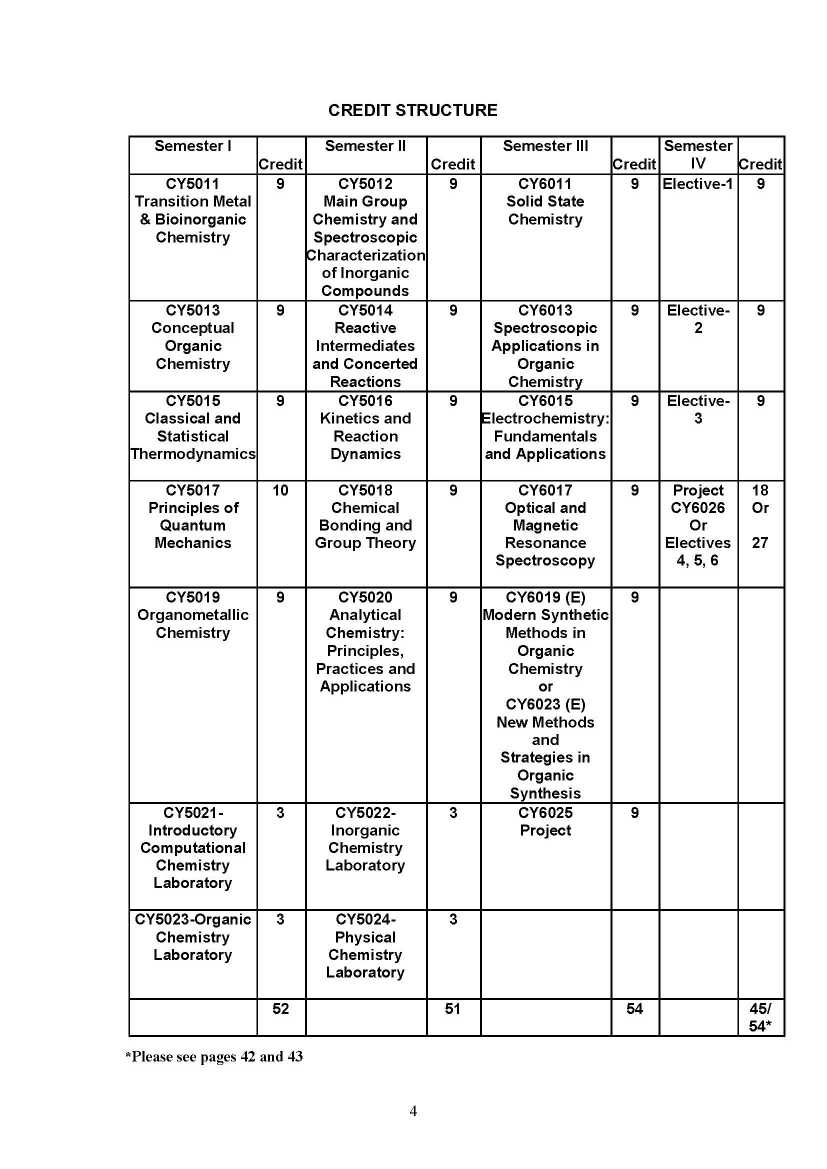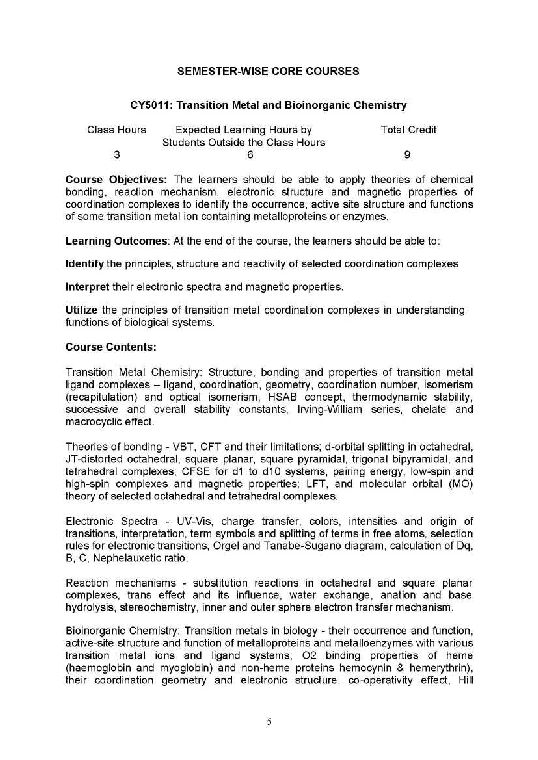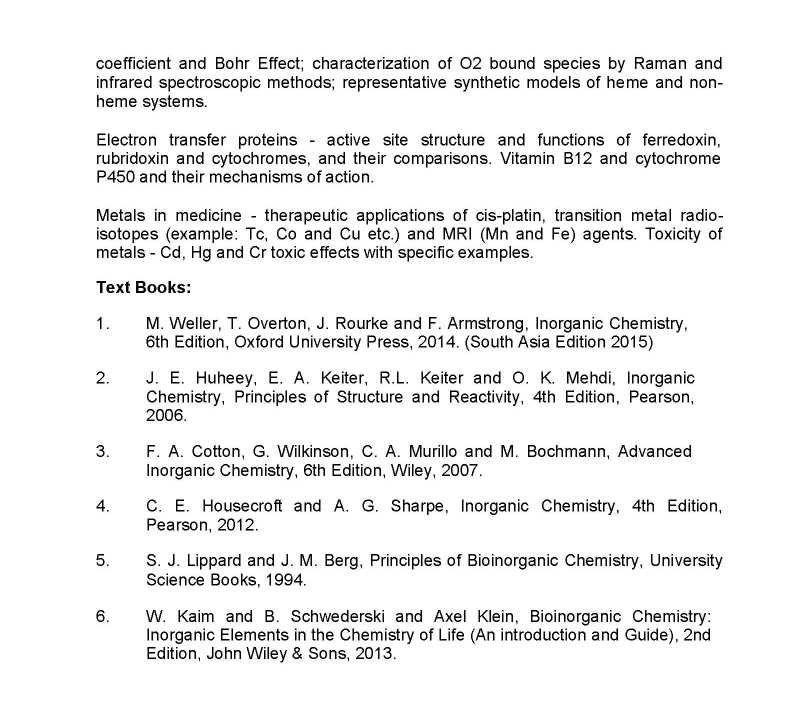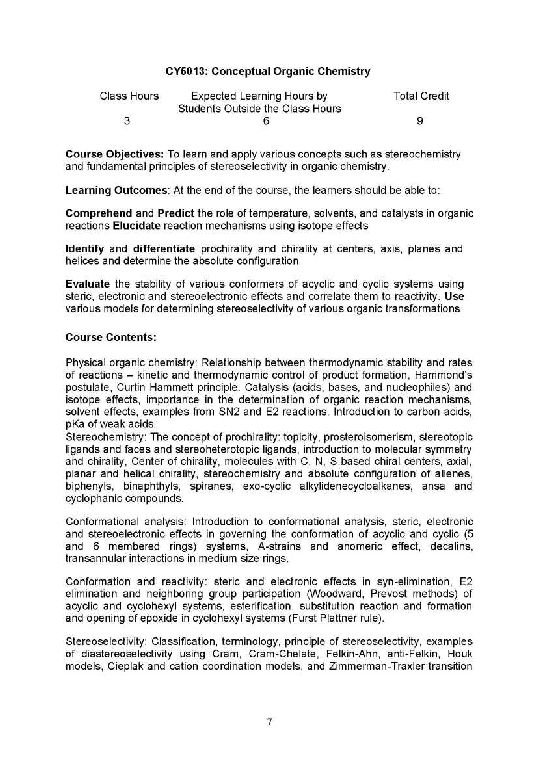|
#1
| |||
| |||
|
Can you provide me the Study Material/Curriculum of M. Sc. Program offered by Department of Chemistry Indian Institute of Technology Madras?
|
|
#2
| |||
| |||
|
The Study Material/Curriculum of M. Sc. Program offered by Department of Chemistry Indian Institute of Technology Madras is as follows: CY5011: Transition Metal and Bioinorganic Chemistry Course Contents: Transition Metal Chemistry: Structure, bonding and properties of transition metal ligand complexes – ligand, coordination, geometry, coordination number, isomerism (recapitulation) and optical isomerism, HSAB concept, thermodynamic stability, successive and overall stability constants, Irving-William series, chelate and macrocyclic effect. Theories of bonding - VBT, CFT and their limitations; d-orbital splitting in octahedral, JT-distorted octahedral, square planar, square pyramidal, trigonal bipyramidal, and tetrahedral complexes; CFSE for d1 to d10 systems, pairing energy, low-spin and high-spin complexes and magnetic properties; LFT, and molecular orbital (MO) theory of selected octahedral and tetrahedral complexes. Electronic Spectra - UV-Vis, charge transfer, colors, intensities and origin of transitions, interpretation, term symbols and splitting of terms in free atoms, selection rules for electronic transitions, Orgel and Tanabe-Sugano diagram, calculation of Dq, B, C, Nephelauxetic ratio. Reaction mechanisms - substitution reactions in octahedral and square planar complexes, trans effect and its influence, water exchange, anation and base hydrolysis, stereochemistry, inner and outer sphere electron transfer mechanism. Bioinorganic Chemistry: Transition metals in biology - their occurrence and function, active-site structure and function of metalloproteins and metalloenzymes with various transition metal ions and ligand systems; O2 binding properties of heme (haemoglobin and myoglobin) and non-heme proteins hemocynin & hemerythrin), their coordination geometry and electronic structure, co-operativity effect, Hill coefficient and Bohr Effect; characterization of O2 bound species by Raman and infrared spectroscopic methods; representative synthetic models of heme and non-heme systems. Electron transfer proteins - active site structure and functions of ferredoxin, rubridoxin and cytochromes, and their comparisons Vitamin B12 and cytochrome P450 and their mechanisms of action Metals in medicine - therapeutic applications of cis-platin, transition metal radio-isotopes (example: Tc, Co and Cu etc.) and MRI (Mn and Fe) agents. Toxicity of metals - Cd, Hg and Cr toxic effects with specific examples Text Books: 1. M. Weller, T. Overton, J. Rourke and F. Armstrong, Inorganic Chemistry, 6th Edition, Oxford University Press, 2014 (South Asia Edition 2015) 2. J. E. Huheey, E. A. Keiter, R.L. Keiter and O. K. Mehdi, Inorganic Chemistry, Principles of Structure and Reactivity, 4th Edition, Pearson, 2006. 3. F. A. Cotton, G. Wilkinson, C. A. Murillo and M. Bochmann, Advanced Inorganic Chemistry, 6th Edition, Wiley, 2007. 4. C. E. Housecroft and A. G. Sharpe, Inorganic Chemistry, 4th Edition, Pearson, 2012. 5. S. J. Lippard and J. M. Berg, Principles of Bioinorganic Chemistry, University Science Books, 1994. 6. W. Kaim and B. Schwederski and Axel Klein, Bioinorganic Chemistry: Inorganic Elements in the Chemistry of Life (An introduction and Guide), 2nd Edition, John Wiley & Sons, 2013 Curriculum M. Sc. Program Department of Chemistry IIT Madras    
__________________ Answered By StudyChaCha Member |